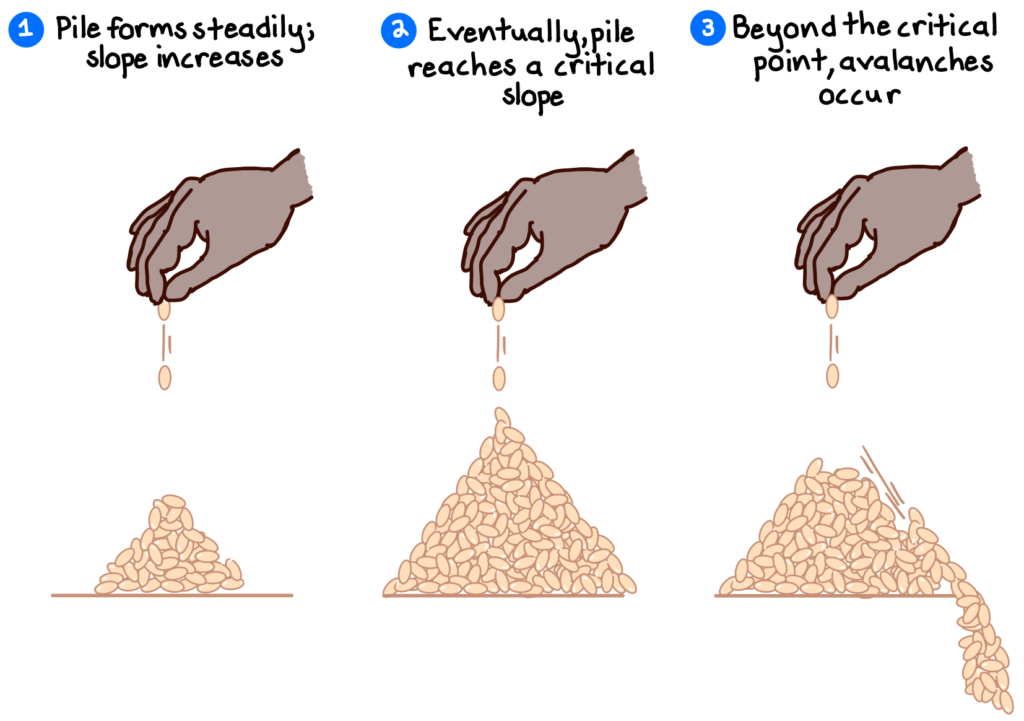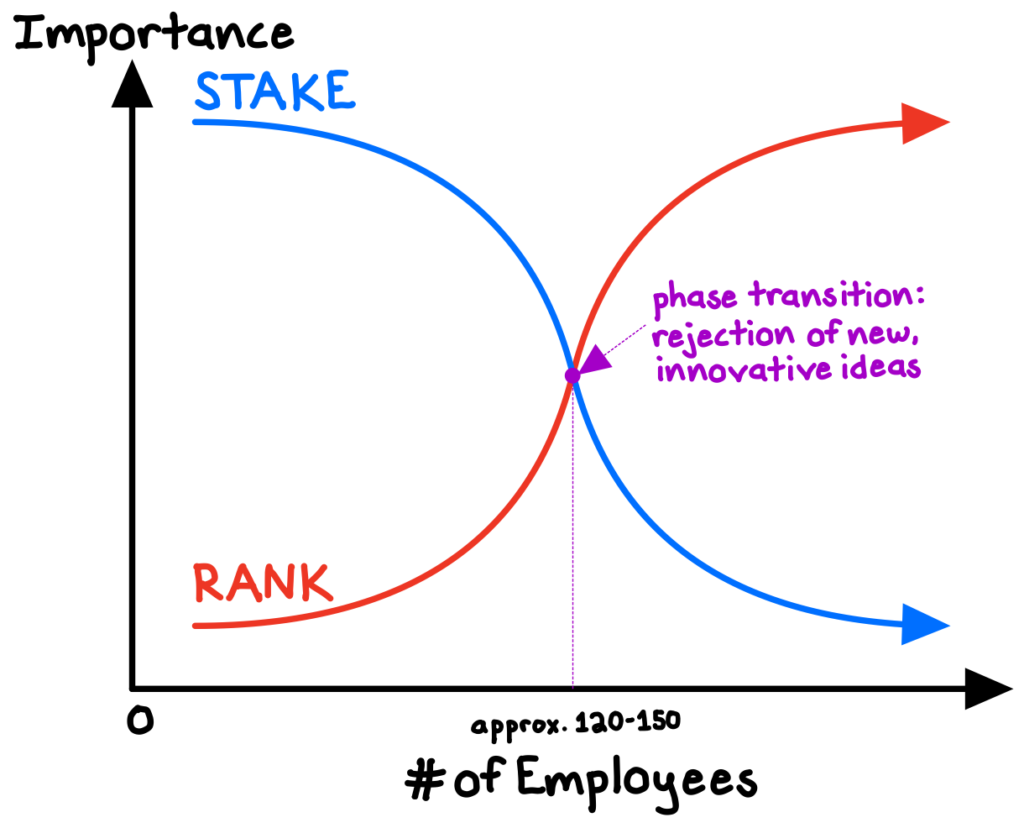A phase transition is the process of change between different states of a system or substance, which occurs when one or more of the system’s control parameters crosses a “critical” threshold.
We tend to take stability for granted, leading us to be caught off-guard when the ground shifts between our feet. By better understanding the dynamics of phase transitions, we can learn to anticipate change and manage it to our advantage.
From stability to phase change
As a simple example, consider an ice cube (a solid), whose key control parameter is temperature. If we apply heat to the ice, the temperature will rise, and the frozen water molecules being held in rigid formation by binding forces will begin to scatter as the water goes through phase transitions of melting (into liquid) and eventually vaporizing (into gas).

Between each phase, there is a range of temperatures in which the state of the system remains stable. It is only once its temperature crosses certain critical thresholds (specifically, 0° and 100° C) that it enters a phase transition.
In fact, this logic helps explain changes in the “phases of matter” (solid, liquid, gas) for all kinds of physical substances as their temperatures fluctuate.1
For us, the real value of the phase transition concept lies in its applicability not only to physical systems (changes in phases of matter), but also to social systems (changes in phases of behavior). In both types, the whole is not only more than the sum of its parts, but it is very different from its parts.
In complex systems, we can’t analyze one component and predict how the whole system will behave, whether it’s one water molecule in a boiling pot, one employee in a company, etc. In each ease, we need to consider the system—its collective behaviors, including the control parameters that can tip it into unpredictable phase transitions.
Avalanches of peace
Imagine dropping grains of sand, one-by-one, onto a countertop. A pile will gradually form, and its slope (the key control parameter) will increase. For a time, each additional grain has minimal effect; the pile remains approximately in equilibrium.
Eventually, however, the pile’s slope will increase to an unstable “critical” threshold, beyond which the next grain may cause an avalanche (a type of phase transition).

Near the critical point, there is no way to tell whether the next grain will cause an avalanche, or how big that avalanche will be. All we know is that the probability of an avalanche is much higher beyond the threshold, and that avalanches of any size are possible, though smaller avalanches will happen much more frequently.
Through a series of avalanches, each of which widens the base of the pile, the sandpile (an inanimate complex system) “adapts” itself to maintain overall stability!
Research has observed the stabilizing role of frequent smaller “avalanches” in a variety of systems, including the extinction of species in nature, price bubbles and bursts in financial markets, traffic jams, forest fires, and earthquakes relieving pressure from grinding tectonic plates.2 These systems unconsciously “self-organize” towards a critical state, beyond which they undergo phase transitions that help preserve equilibrium, over time.
Growing to death
For those of us who work in organizations, the science of phase transitions provides insight into how to nurture innovation, and how to avoid destructive breakpoints.
Just as avalanches occur with a steep enough pile, high-performing teams in every creative industry unexpectedly shift as they grow over time, often to their own detriment. Consider the fate of former industry titans who, once on top, failed to adapt to a shifting technological landscape—PanAm, Nokia, Kodak, Blockbuster, and so on.
“Growth will break your company.”
Tony Fadell, Build (2022, pg. 242)
Team size is a key control parameter. With small teams (up to ~15 people), every member’s stake in the results of the project are very high. There’s no need for management. Communication happens naturally. Up to 40-50 people, some silos and sub-teams begin to form, but individual stakes remain high, and most interactions remain informal.
However, as teams and companies scale (particularly beyond 120-150 people), individual stakes in project outcomes decline, while the perks of rank (job titles, salary growth) increase until, when the two cross, the system “snaps” and incentives begin encouraging unwanted behavior: the rejection of risky but potentially groundbreaking ideas.3

Moreover, layers of management form, information becomes siloed, jobs become more specialized, culture drifts, and people-related issues explode. Further growth magnifies these problems.
Managing these transitions successfully requires careful design of incentives, org structure, and roles and responsibilities. To do so, we should consider a portfolio of preemptive actions:4,5
- Increase “project-skill fit” — Search for and correct mismatches between employee skills and project needs. Employees who are well-matched to their assignments will take more ownership of the outcomes.
- Non-political promotions — In promotion decisions, emphasize independent assessment from multiple sources over politics (reliance on the manager).
- Get the incentives right — Motivate others with “soft equity” rewards such as peer recognition, autonomy, and visibility. External rewards such as money should be based on milestones or outcomes that individuals can actually control. Too many incentive structures rely on perverse schemes such as earnings-based compensation for junior employees, who have no direct influence on those metrics.
- Decentralize — Once you have multiple products, you will need to split your org into individual product groups, sort of “mini-startups” within the business that are more nimble and autonomous.
- Optimize “management spans” — For teams focused on innovative new projects (R&D), consider increasing the average number of direct reports per manager to encourage looser controls and more trial-and-error. For “franchise” groups that focus on growing existing businesses, consider narrowing management spans to encourage tighter controls and measurable outcomes (since failure is more costly).
***
Whether in an organization, relationship, laboratory, or highway, we can improve our decision-making by investigating the control parameters governing the stability of our system—and the thresholds beyond which chaotic phase transitions may occur.
We cannot simply extrapolate linearly from the present. Even if our company, our marriage, or our environment is stable at the moment, small changes in critical factors can create unpredictable change. We can either be surprised by the pervasive phase transitions in our lives, or we can anticipate them and harness them to our advantage.
Notes
- Bahcall, S. (2019). Loonshots. St. Martin’s Press. 9-14.
- Ouellette, J. (2014, April 7). Sand Pile Model of the Mind Grows in Popularity. Quanta Magazine.
- Bahcall, S. (2019). 193-199.
- Bahcall, S. (2019). 209-224.
- Fadell, T. (2022). Build. HarperCollins. 244-251.

